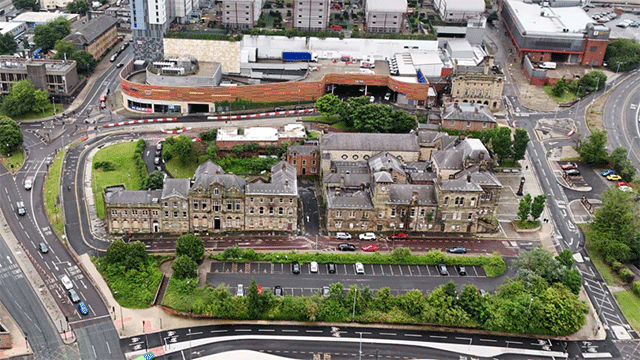As ESG continues to move up the agenda in the investment and development world, with increasing regulatory pressures to design, deliver and invest in sustainable and socially responsible ways, Cushman & Wakefield has come up with a new tool to provide a roadmap to deliver inclusive cities.
The Inclusive Cities Barometer for EMEA looks at the performance of 44 cities across the region from an economic, social, spatial and environmental inclusivity perspective with the aim of creating a data-driven dialogue on the influence real estate has on urban inclusion and the social fabric of cities.
The report analyses some 5,000 data points covering 110 variables.
Sophie Schuller, lead researcher at Cushman & Wakefield and author of the report, said the 44 cities included in the report were at varying stages of their journey towards more inclusive urban environments but that by analysing their progress, it could “highlight exemplary successes and outline actionable pathways for improvement”.
Schuller, who describes her job as understanding the intersection between people and buildings to showcase the alternative value of real estate, is keen for the report to be used as a tool to help properly articulate what inclusivity means.
For Cushman, inclusivity covers four key areas in our cities: economic, which looks at employment and jobs; spatial inclusivity, which looks to the openness of a place, ie whether people from all backgrounds are welcome everywhere; environmental, which looks at the more human health-related side of sustainability, such as air quality and walkability; and the more traditional social inclusivity.

Inclusive leaders
Rotterdam came out as the strongest overall performer in the barometer. Boasting Europe’s largest harbour, it is a city with a rich history as a hub of transition and one that focuses on ensuring a wide range of jobs across the socio-economic spectrum, found Cushman. It also scores well on social inclusion through initiatives such as the redevelopment of Rotterdam South, which has a strong emphasis on enhancing the quality of housing and public transport links and environmental inclusion with its sustainable ports programme.
Other strong performers in the barometer include Copenhagen, which ranked highly for its economic inclusivity; Amsterdam, which was top for social inclusivity; Madrid, which has been planting 1.5m trees along a 75km corridor to help cool the city, came top for environmental inclusivity; while Glasgow was the best performer when it came to spatial inclusivity.
Cushman said that with its robust transportation network, connecting people from disparate residential areas to many centres of work and employment, Glasgow stood as an example in spatial inclusivity.
Size matters
When it comes to inclusivity, size matters, with both London and Paris sitting behind many of the top-performing cities in the barometer. Cushman said large populations trying to access social infrastructure caused challenges for megacities.
However, it found that London’s inclusivity was driven by its talent pool and from being one of the most diverse and multicultural cities in the world, with more than 300 languages spoken and strong inclusivity for the LGBTQ+ and disabled communities, alongside strong gender equality.
London’s lack of housing availability is prohibitive to its inclusivity, however, added Cushman, with property prices among some of the most expensive globally. Despite a high-quality and accessible public transport system, the costs reduce overall inclusivity of accessibility – especially as more expensive accommodation pushes residents into the suburbs. The capital also has a significant focus on the knowledge economy and to score well in employment inclusivity will need to balance this with manual and labour-based jobs.
“It is worth noting that there is no such thing as a perfect city,” said Schuller. “All the 44 cities have their respective strengths and diverse backgrounds and challenges, and this barometer serves to provide learning points and actions that they can adopt and adapt as they pursue their urban inclusivity agenda.”
Lessons for real estate
But what can real estate investors and developers learn from the barometer?
Schuller wants it to act as an educational tool and a prompt for the commercial real estate industry to challenge the social status quo. She hopes the barometer offers guidelines on integrating and enhancing social value at every decision-making stage – from individual assets to city-wide portfolios.
“If we [the real estate sector] are 75% contributing to the shape and face of all of our cities, then we have not only a critical role, we arguably have the most responsibility to make sure that the development of our cities not just services our clients but all citizens and users of these buildings.”
James Woodhead, head of EMEA ESG at Cushman & Wakefield, said: “If we look at the core office employment hubs, developers can accommodate more nuanced and inclusive needs, not only of the end users of their office spaces but also the communities and people who live close to or walk past their buildings every day. From an investment perspective, developing the social value of assets will also influence total returns.
“A city’s attractiveness and long-term viability are profoundly shaped by its inclusive and social values. Inclusive cities naturally draw in greater talent and foster innovation, resulting in increased investment and growth,” added Woodhead.
“These cities provide opportunities for social mobility and entrepreneurship across diverse socio-economic backgrounds. Their resilience and adaptability also enable them to meet the evolving needs and expectations of their residents and stakeholders. It is crucial for the real estate sector to wholeheartedly embrace and integrate inclusive values into all its activities.”
To help investors and developers with that integration, Cushman has laid out a number of key considerations at both a local and building level in the report, including close consultation with local stakeholders, cultivating a supply chain that provides jobs for local residents and putting safety and experience high on the agenda.
Send feedback to Samantha McClary
Follow Estates Gazette











